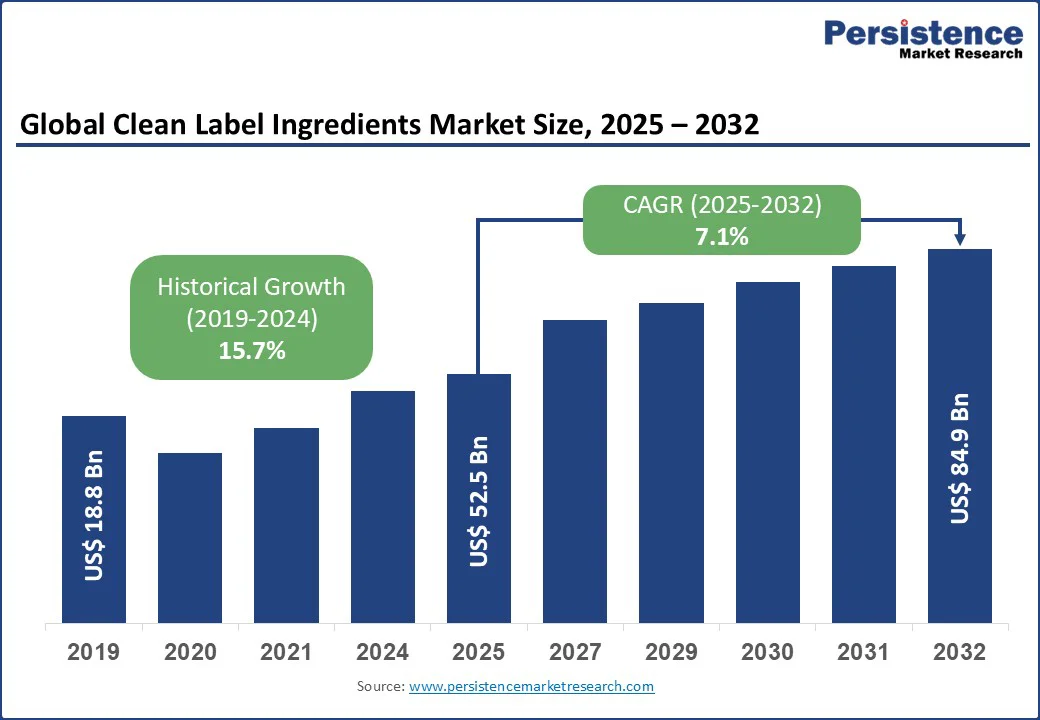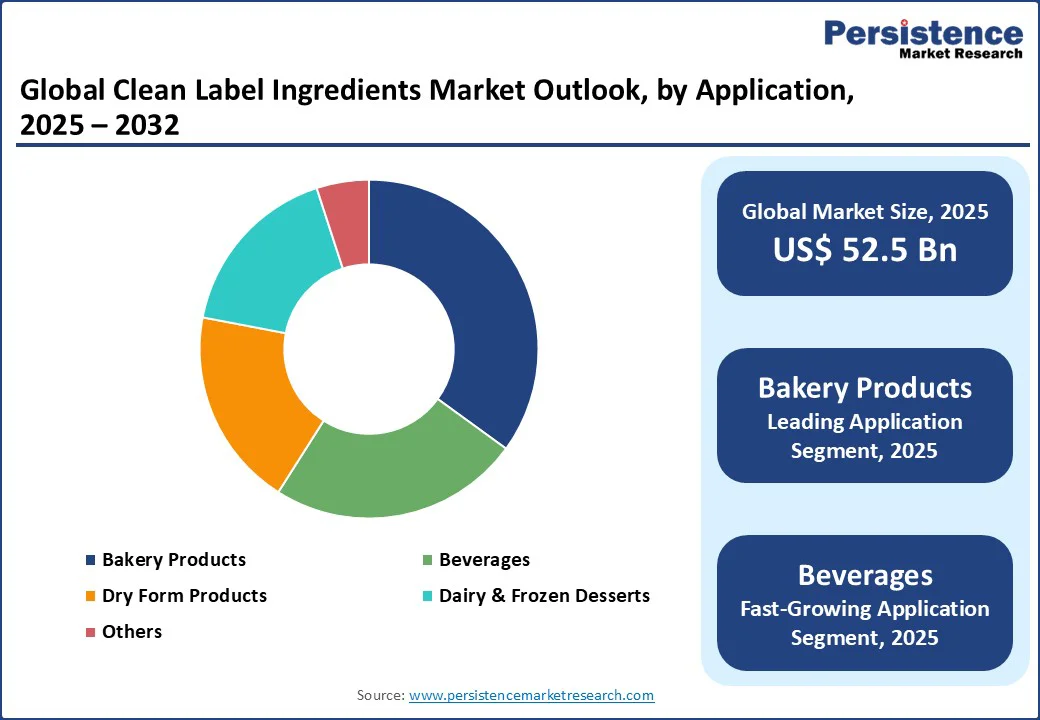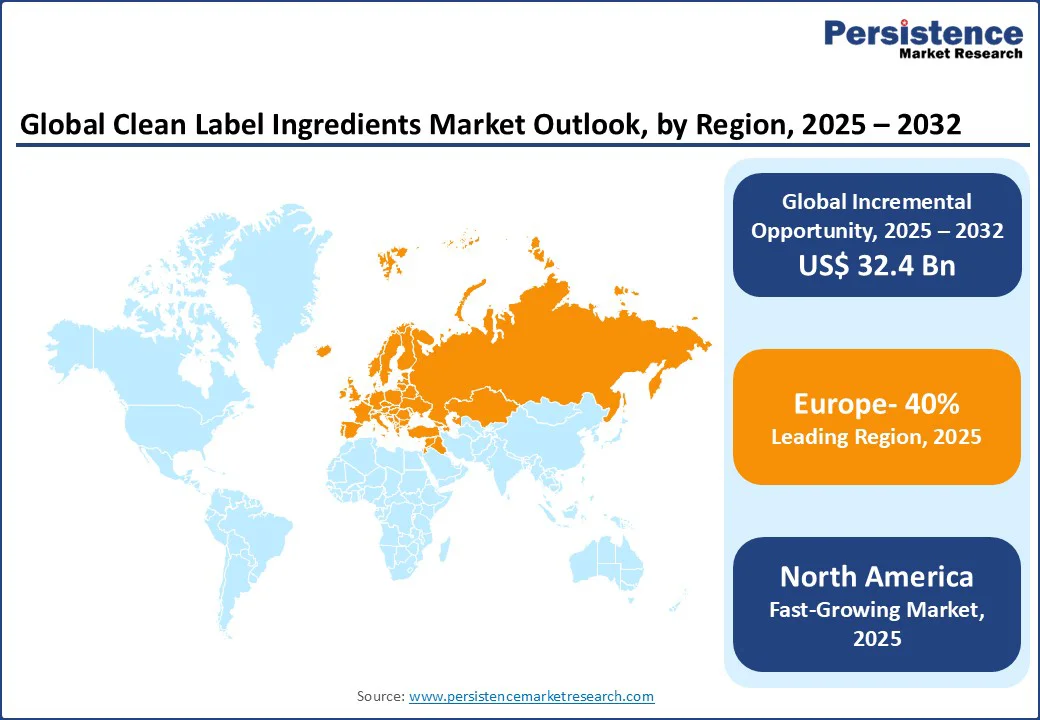ID: PMRREP33706| 178 Pages | 10 Oct 2025 | Format: PDF, Excel, PPT* | Food and Beverages

The global clean label ingredients market size is expected to be valued at US$52.5 billion in 2025 and is projected to reach US$84.9 billion by 2032, growing at a CAGR of 7.1% during the forecast period from 2025 to 2032.
Growth is largely fueled by consumers’ increasing preference for natural, minimally processed, and transparently labeled food products. Rising health consciousness, demand for plant-based and organic options, and clean-label baked goods, beverages, and snacks are key drivers.
Supportive regulations for ingredient transparency, along with innovations in natural flavors, preservatives, and functional ingredients, further enhance adoption across the food and beverage sector.
| Key Insights | Details |
|---|---|
| Clean Label Ingredients Market Size (2025E) | US$52.5 Bn |
| Market Value Forecast (2032F) | US$84.9 Bn |
| Projected Growth (CAGR 2025 to 2032) | 7.1% |
| Historical Market Growth (CAGR 2019 to 2024) | 15.7% |

The clean label ingredients market is witnessing robust growth due to rising consumer demand for natural and transparent food products. Modern consumers are increasingly focused on health and wellness, preferring products with simple, recognizable ingredients and free from artificial additives or preservatives.
This shift is encouraging food manufacturers to reformulate their offerings using clean label ingredients, such as natural colorants, flavors, and preservatives, to meet evolving preferences for transparency and trust in food sourcing.
Government initiatives are also supporting this trend. In India, for instance, the Ministry of Food Processing Industries emphasizes the promotion of natural and minimally processed food products. Similarly, the Food Safety and Standards Authority of India (FSSAI) has implemented regulations mandating clear and accurate labeling on pre-packaged foods, enabling consumers to make informed choices. These combined factors are accelerating the adoption of clean-label ingredients across the food and beverage sector.
The clean label ingredients industry faces notable restraints due to the high costs associated with natural and minimally processed ingredients. Compared to synthetic additives, clean label alternatives often involve more expensive sourcing, processing, and quality assurance. These elevated costs can pose significant challenges for food manufacturers, particularly in price-sensitive markets, making the large-scale adoption of clean label solutions less economically viable.
In addition to cost concerns, clean label ingredients often have functional limitations. Natural preservatives, colorants, and flavorings may exhibit lower stability, shorter shelf life, or reduced effectiveness compared to their synthetic counterparts. These constraints can impact product consistency, texture, and overall sensory appeal, necessitating that manufacturers invest in specialized formulation techniques to maintain product quality while adhering to clean label standards.
The clean label ingredients market is poised to benefit significantly from the growing popularity of plant-based and organic foods. Consumers are increasingly seeking healthier, environmentally friendly alternatives, driving demand for products made from natural, plant-derived ingredients. This trend encourages manufacturers to incorporate clean label solutions that align with plant-based and organic product lines, such as natural protein isolates, botanical extracts, and organic flavorings.
Additionally, the surge in plant-based and organic diets is supported by rising awareness of sustainability and ethical food production. As more consumers prioritize transparency and ingredient integrity, food and beverage companies are presented with an opportunity to innovate and differentiate their offerings. This expansion in demand is expected to accelerate the adoption of clean label ingredients across a wide range of products, from snacks and beverages to dairy alternatives.
In 2025, powder form clean label ingredients are expected to dominate the market with a 62% market share. Their widespread use is attributed to their versatility, ease of storage, and longer shelf life, making them suitable for applications in the bakery, confectionery, and instant food industries. Additionally, powdered ingredients allow for accurate dosing and consistent quality, which is crucial for manufacturers focusing on clean label compliance.
Liquid form ingredients are experiencing the fastest growth. The increasing demand for ready-to-drink beverages, sauces, and functional drinks is driving this trend, as liquid ingredients offer better solubility, faster integration, and improved flavor delivery. Innovations in preservation and stabilization techniques are further encouraging the adoption of liquid clean label solutions across the food and beverage sector.
In 2025, natural flavors hold the largest share in the clean label ingredients market at 25%. Their strong position is supported by growing consumer demand for familiar, minimally processed ingredients that enhance taste without the use of synthetic additives. Natural flavors are extensively used in beverages, snacks, and confectionery, allowing manufacturers to maintain consistent flavor quality while adhering to clean label standards.
Fruit and vegetable ingredients are the fastest-growing segment. Rising consumer interest in plant-based, nutritious, and health-focused foods is driving this trend. Advances in processing and preservation technologies are making it easier to integrate fruit and vegetable ingredients into a wide range of products, allowing manufacturers to meet both flavor and functional requirements while expanding their clean-label offerings.
In 2025, bakery products accounted for the largest share of the clean label ingredients market, at 35%. Their dominance is attributed to strong consumer preference for baked goods made with natural, minimally processed ingredients. Using clean label solutions in bakery items ensures consistent quality, texture, and flavor while meeting the increasing demand for transparency and healthier food choices.
The beverages segment is the fastest-growing. Rising consumption of ready-to-drink beverages, functional drinks, and plant-based alternatives is driving this expansion. Clean label ingredients in beverages help improve flavor, nutritional content, and stability, enabling manufacturers to cater to consumer expectations for natural, convenient, and health-oriented products.

North America is the fastest-growing region in the clean label ingredients market, driven by increasing consumer awareness of health, wellness, and transparency in food products. Consumers in the U.S. and Canada are actively seeking foods with natural, minimally processed ingredients and clear labeling, driving demand for clean label solutions across various categories, including bakery, beverages, snacks, and dairy alternatives.
The rising adoption of plant-based and organic products, coupled with stringent regulatory frameworks for food labeling, is further encouraging manufacturers to reformulate their products with clean-label ingredients. Additionally, innovation in natural preservatives, flavors, and functional ingredients is enabling companies to meet consumer expectations, making North America a key hub for growth.
Europe is expected to lead the clean label ingredients market, accounting for a 40% share by 2025. The region’s dominance is driven by strong consumer demand for natural, minimally processed, and transparently labeled food products. European consumers prioritize health, wellness, and sustainability, prompting manufacturers to adopt clean label ingredients across a wide range of applications, including bakery, beverages, snacks, and dairy products.
Strict food safety and labeling regulations further reinforce the use of clean label solutions, ensuring ingredient transparency and quality. Additionally, ongoing innovation in natural flavors, colors, and preservatives enables European companies to meet consumer expectations while maintaining product stability, positioning the region as the largest and most mature market for clean-label ingredients globally.
The Asia Pacific region holds a significant share, driven by rising consumer awareness of health, wellness, and food transparency. Growing urbanization, increasing disposable incomes, and changing dietary preferences are fueling demand for natural, minimally processed products across countries such as China, India, Japan, and Australia.
The region is witnessing the rapid adoption of bakery, beverages, snacks, and dairy items made with clean-label ingredients. Additionally, government initiatives promoting food safety and labeling standards, along with innovations in natural preservatives, flavors, and functional ingredients, are supporting growth, making the Asia Pacific a key contributor to the global industry.

The global clean label ingredients market is highly competitive, driven by continuous innovation and product differentiation. Companies are focusing on developing natural, minimally processed solutions that align with consumer demand for health, transparency, and sustainability.
Key strategies include new product launches, partnerships, and advancements in natural flavors, preservatives, and functional ingredients. Manufacturers are also enhancing production capabilities and investing in research to improve shelf life, flavor, and stability, enabling them to strengthen their market presence and capitalize on growth opportunities in this dynamic sector.
The clean label ingredients market is projected to reach US$52.5 bn in 2025, driven by demand for natural ingredients.
Consumer preference for transparency, health-conscious diets, and organic food trends fuel growth.
The clean label ingredients market will grow from US$52.2 bn in 2025 to US$84.9 bn by 2032, with a CAGR of 7.1%.
Plant-based trends, organic food growth, and e-commerce expansion drive opportunities in beverages and snacks.
Leading players include Cargill, ADM, Koninklijke DSM N.V., DuPont, Kerry Group Plc, Tate & Lyle Plc, Corbion Inc., Frutarom, Sensient Technologies, and Ingredion Incorporated.
| Report Attribute | Details |
|---|---|
| Historical Data/Actuals | 2019 - 2024 |
| Forecast Period | 2025 - 2032 |
| Market Analysis | Value: US$ Bn, Volume: As Applicable |
| Geographical Coverage |
|
| Segmental Coverage |
|
| Competitive Analysis |
|
| Report Highlights |
|
By Form
By Flavor Type
By Application
By Region
Delivery Timelines
For more information on this report and its delivery timelines please get in touch with our sales team.
About Author